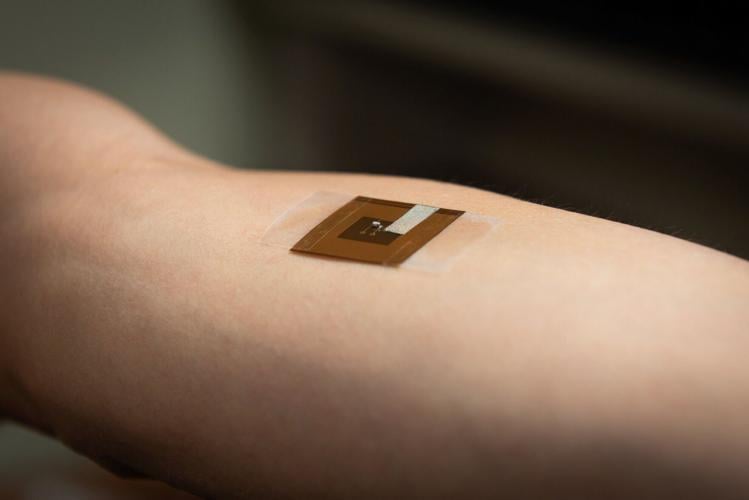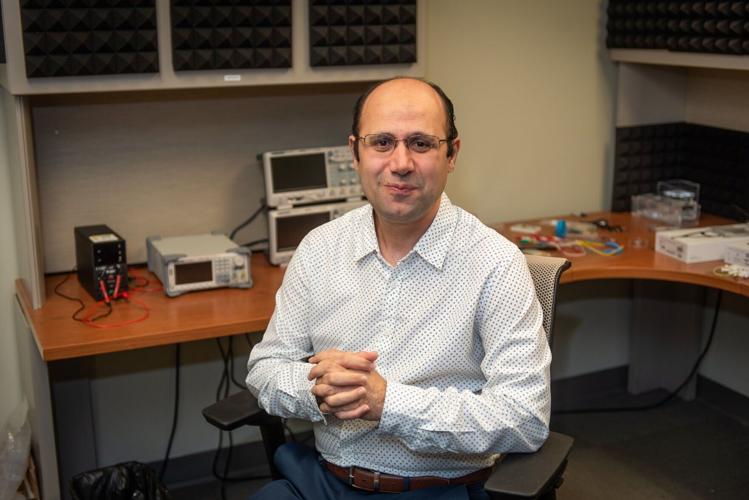
Researchers at Wake Forest University School of Medicine designed a flexible, chip-less, battery-free patch that is placed directly on the skin and works wirelessly with a small reader device. (Wake Forest University School of Medicine via SWNS)
By Stephen Beech
A new wearable patch can detect early signs of the deadliest form of skin cancer.
The wireless device allows screening of patients at home so melanoma can be caught sooner - potentially reducing the risk of unnecessary biopsies, say scientists.
American researchers developed the ground-breaking, battery-free patch that could potentially save lives by making screening more accessible and less invasive.
They explained that skin cancer, especially melanoma, is one of the most dangerous forms of the disease.
Early detection is critical for successful treatment, but current methods often rely on visual inspection, which can be subjective and may miss vital early warning signs.
More advanced diagnostic tools - such as biopsies and imaging - are often only available in specialised clinics.
Dr. Mohammad Moghimi, who led the development, says the new patch measures the electrical properties - or bioimpedance - of skin lesions in a "simple, non-invasive" way.
He explained that bioimpedance indicates how easily electrical signals pass through living tissue.
Cancerous areas often have different electrical properties than healthy skin.
By measuring bioimpedance, the patch can help identify "abnormal" areas that may require further medical evaluation.

Dr. Mohammad J. Moghimi, assistant professor of biomedical engineering at Wake Forest University School of Medicine, led the development of a new patch that measures the electrical properties (bioimpedance) of skin lesions in a simple, non-invasive way. (Wake Forest University School of Medicine via SWNS)
The research team at Wake Forest University School of Medicine in North Carolina, designed a flexible, chip-less, battery-free patch that is placed directly on the skin and works wirelessly with a small reader device.
To test its effectiveness, the team recruited 10 volunteers.
Each participant had the patch placed on both a pigmented skin lesion - such as a mole - and nearby healthy skin.
The patch used safe electrical signals to measure bioimpedance.
Standard statistical methods confirmed "significant" differences between healthy and abnormal skin.
The study, published in the journal npj Biomedical Innovations, showed that the patch could "clearly" distinguish between healthy skin and spots that might be a concern.
It picked up "unique" electrical signals from suspicious moles or lesions regardless of skin tone.
Study principal investigator Dr. Moghimi said: “Skin cancer is most treatable when caught early, but many people don’t have easy access to specialised dermatology care.
“Our wearable patch is designed to be affordable, comfortable and easy to use, even outside of a doctor’s office.
"It could empower patients and primary care providers to monitor suspicious skin lesions and seek help sooner.”

(Photo by Karola G via Pexels)
He says the patch is unique because it does not require batteries or chips, making it lightweight, disposable and cost-effective.
Unlike visual inspection, Dr. Moghimi says the patch provides objective, numerical data about the skin’s health, reducing the risk of unnecessary biopsies and helping doctors to make more informed decisions.
He said the patch provides additional information about lesions that enhances and supports other diagnostic techniques such as imaging-based methods.
Dr. Moghimi says the patch works equally well across all skin tones and can detect changes in small or visually ambiguous lesions.
It also generates non-visual, numerical data, reducing privacy concerns and making it easier to store and share results.
Dr. Moghimi, Assistant Professor of biomedical engineering at Wake Forest, said: “Our goal is to make early skin cancer detection accessible to everyone."
He added: “By providing a tool that can be used at home or in primary care settings, we hope to reduce the number of missed or late diagnoses and improve patient outcomes.”
The research team plans to further improve the patch by integrating conductive hydrogel electrodes for even better performance and comfort.
Dr. Moghimi says the next phase will involve larger clinical studies to test the patch’s effectiveness in real-world settings and to determine how well it can distinguish between benign and malignant lesions.























(0) comments
Welcome to the discussion.
Log In
Keep it Clean. Please avoid obscene, vulgar, lewd, racist or sexually-oriented language.
PLEASE TURN OFF YOUR CAPS LOCK.
Don't Threaten. Threats of harming another person will not be tolerated.
Be Truthful. Don't knowingly lie about anyone or anything.
Be Nice. No racism, sexism or any sort of -ism that is degrading to another person.
Be Proactive. Use the 'Report' link on each comment to let us know of abusive posts.
Share with Us. We'd love to hear eyewitness accounts, the history behind an article.